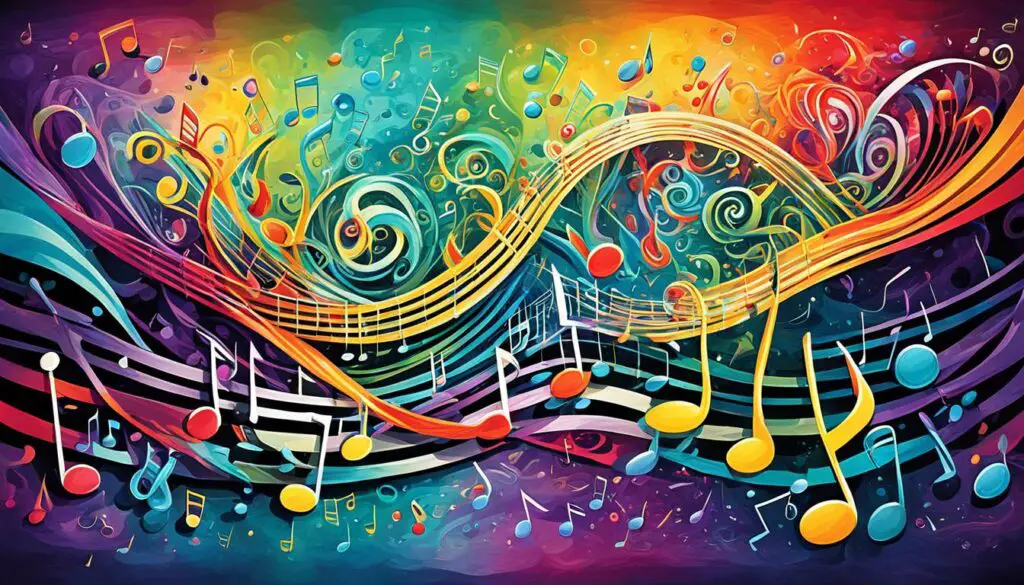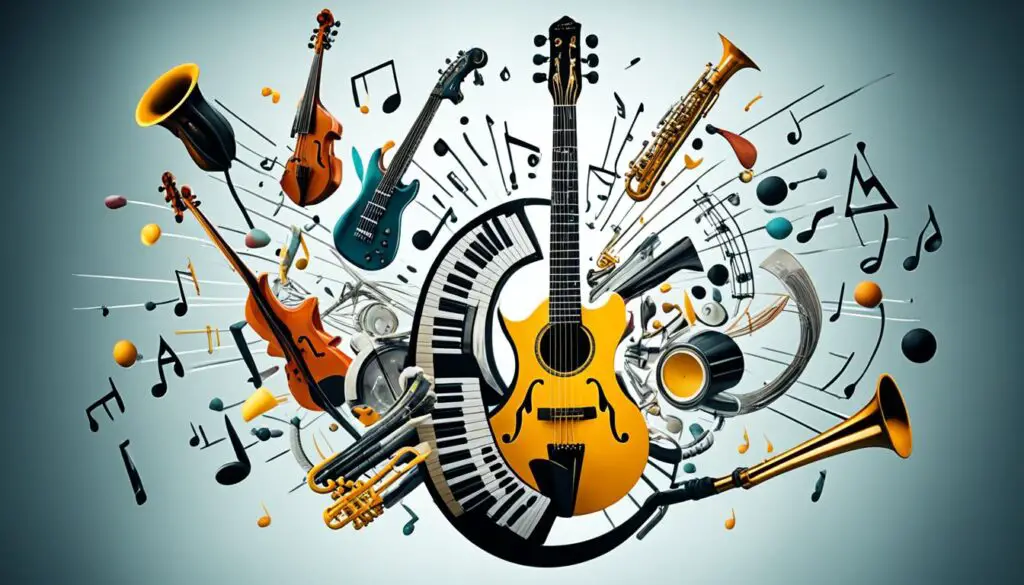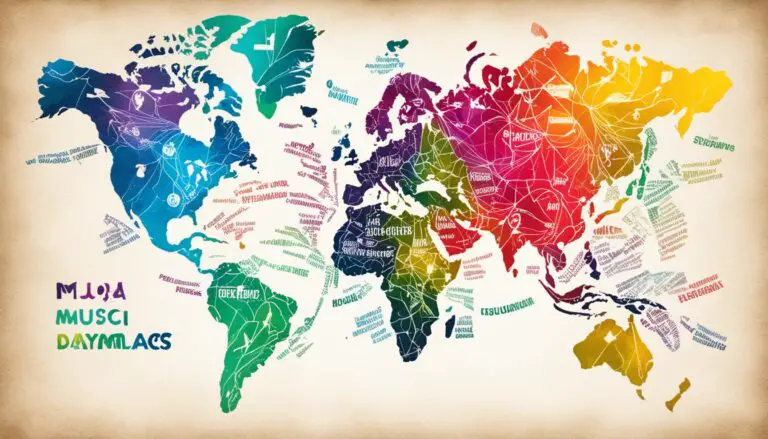Over 50 million people went to major electronic dance music (EDM) festivals around the world in 2022. This shows how much the genre has grown and that people love new music. The music world has gone through a fascinating journey, changing and mixing in ways that completely change our idea of music.
Music is always changing, reflecting the shifts in culture and society over time. It has led to the rise of hybrid music genres. These new styles mix different types of music, creating fresh and surprising sounds. Hybrid genres show that music is flexible and alive, especially in a time where there are fewer limits between cultures.
This change is fuelled by a desire to mix the familiar with new ideas. It started early on, with genres like Rock n’ Roll blending Blues and Country. Now, we see new mixes, like EDM and folk music. These creative blends question what we know about music types and make the music world richer.
Key Takeaways
- Music genres have evolved significantly over the centuries, mirroring cultural and societal shifts.
- The emergence of hybrid music genres represents a creative amalgamation of distinct musical traditions.
- Hybrid genres signify the adaptability and dynamic nature of music, reflecting an era of blurred cultural boundaries.
- The desire to blend the familiar with the novel has given rise to innovative and unexpected sonic landscapes.
- Hybrid genres challenge the traditional understanding of music genres and redefine the musical experience.
The Roots of Musical Evolution
Today’s music world is like a colourful tapestry, made over time. It’s filled with different sounds, all connecting to rich cultures and histories. For instance, genres such as Classical, Jazz, and Blues have deep stories. They didn’t just appear – they changed and grew over many factors. These include where people lived, politics, and even how societies evolved.
Classical Music’s Foundational Influence
Classical music has its beginnings in both church and worldly music in the Western world. It set the stage for complex music patterns and ideas. Classical music inspired the creation of many new styles by exploring unique musical techniques and forms.
Jazz: A Melting Pot of Styles
Jazz came alive in New Orleans among African-Americans. It mixed the musical flavours of blues, ragtime, and more into a vibrant blend. This mix brought the art of improvisation and the joy of fusing cultures together. Jazz has been a massive influence on the music world, sparking creativity and new ideas.
The Soulful Narratives of Blues
The genre known as the Blues told deep, emotional stories of struggles. Its impact can be felt in Rock and Roll, Soul, and even Hip-Hop. These genres borrowed the raw emotion and complex rhythms of Blues. This influence helped shape their own unique sounds.
Artists, along with the people who listened, history, and technological progress all played a part in making music what it is today. For example, the invention of the recording device changed how we share music. It broke down barriers, allowing new styles to be born through mixing and experimenting.
The Rise of Hybrid Genres
The birth of hybrid music genres changed the music scene. It started blending different music styles together. The result was not just a mix but a new kind of music that excited everyone.
Rock n’ Roll: A Revolutionary Blend
Rock n’ Roll kicked off the hybrid genre journey back in the 1950s. It mixed Blues and Country music with gospel and jazz. This mix wasn’t only about music. It was a cultural symbol that broke the norm and spoke for the young.
Technological Advancements and New Fusions
With new technology, making hybrid genres became easier. Electronic tools and instruments made it all happen. This led to cool mixes like Synthpop and the blend of Hip-Hop with electronic dance music (EDM).
These hybrid genres didn’t just change the music world. They mirrored the changing culture and times. They showed our drive to explore and create new things, embodying our urge for innovation.
Modern Hybrid Genres and Their Impact
The music scene today is bursting with hybrid genres. These styles prove that there are endless paths for musical creativity. They mix old with new, linking songs from different times and cultures. For example, Electro Swing mixes vintage swing with modern beats. Neo-Soul combines Soul, R&B, Jazz, and Hip-Hop. These blends offer a new way to enjoy old and new sounds.
Transcending Cultural Barriers
Billie Eilish and BTS are spreading the word about hybrid music. Billie mixes Pop with Electronic and Indie vibes. BTS adds Western tones to their K-Pop base. Their music speaks to people worldwide, jumping over genre and cultural walls. It’s not just about the songs; their influence touches fashion, language, and daily life. This helps bring cultures together in a modern, global way.
Influence Beyond Music
Hybrid music is turning up the volume beyond sounds. It’s impacting what we wear, how we speak, and who we are. This change shows that our world is moving towards openness and global friendships. It’s about sharing cultures and making them our own.
The Role of Globalization and Digital Media
In recent years, there has been a big growth in music that mixes different styles. This has a lot to do with the world getting more connected and digital media. Thanks to this, music from different parts of the world can mix. For example, you can find a mix of Latin and Pop music.
This mixing of music has made the industry richer. It also helps people learn about and enjoy other cultures.
Global Exchange of Sounds
Globalization has brought musicians from different backgrounds together. They are creating music that is new and exciting. Genres like post-punk revival have become popular worldwide because they are different and meaningful. This shows how important it is for music to travel across the globe.
Digital Platforms and Accessibility
Digital media has changed how we share and listen to music. Places like YouTube, Spotify, and SoundCloud are key in spreading new types of music. They give small and unique genres a chance to be heard by people everywhere.
On top of that, social media helps artists connect with their fans. It’s a space where they can share their work and create new music together. The digital age has also made it easier for anyone to make music. Home studios and digital music tools have opened up music creation to more people. This leads to more creativity and fresh ideas in music.
music genres, evolution of music
Hybrid music genres blend different styles, creating something new. They mix art with culture and face big challenges. Artists must keep their work real while mixing genres. They need to stay true to the original style they mix with.
But, some people say these new genres aren’t authentic. They think mixing styles makes the music less pure. This debate shows a big problem. It’s hard to mix old and new without upsetting someone.
And then, there’s the problem of making money from these new styles. If they get too popular, they might lose their special touch. They could become simple and made just to sell. This makes it hard for artists to connect with their audience. Some people love the new mix, but others may not get it.
Still, many musicians are not letting this stop them. They’re using these new genres to say something important. Their music helps make the world of music more diverse and interesting. They’re talking about who we are and how our art is always changing.
Challenges and Criticisms
The rise of hybrid music genres is a thrilling time for music lovers. Yet, it comes with its own set of hurdles and criticisms. These genres mix different styles in innovative ways. But, picking through artistic, commercial, and cultural considerations is not easy.
Maintaining Authenticity
Keeping it real is tough when blending genres. Finding the right mix between tradition and newness is a fine line. Some people say these hybrid genres take away from the true nature of traditional music. They argue it’s about keeping the past alive while moving forward.
Commercialisation and Mainstream Appeal
There’s also the issue of becoming too commercial. With fame comes the pressure to sell more. This can change the original artistic message just to please more people. It ends up simplifying the complex beauty of these new sounds for the mainstream.
Audience Reception
Winning over the crowd can be tough for hybrid genre artists. Some people love the classics and are slow to embrace what’s new. Others might not fully understand these mixed types of music yet. It takes time to be discovered and appreciated.
Even with all these challenges, artists are steering ahead. The hybrid genres aren’t just new ways to listen to music. They’re open doors for creativity and conversation. They talk about who we are, how we differ, and the changeability of what we call art.

Future of Music Genres
Boundless Musical Landscapes
The future of music looks exciting and limitless. We’re moving towards a world where music genres mix, creating new sounds. It’s all because artists love to experiment and break the old rules.
Technological Advancements and Artistic Expression
New technology is changing the way we make and enjoy music. It lets artists be even more creative, opening up new horizons for their music. With AI and virtual reality, what we know as music will change, blending different styles and cultures.
This will make the music scene more diverse and welcoming for everyone. We’ll hear sounds that we’ve never imagined, bringing joy and fresh vibes. So, get ready for a future where music is brimming with surprises!
Early Music Genres
The early 1900s were an exciting time in music history. This era marked the beginning of what we now know as the 20th and 21st-century early music genres. Blues music started it all in 1900. It came from African American spirituals. Blues became famous when W. C. Handy published Memphis Blues in 1912. By the 1920s, jazz, country, and folk music had also grown in popularity. Jazz was born in New Orleans, country music with the people in the South, and folk music stood out during the Depression.
The music scene changed in the 1940s through the 1960s. This era brought us Rhythm and blues (RnB), bluegrass, soul, rock, and disco. Rap and hip-hop entered in the 1970s, followed by pop and other new genres. Looking back at the early genres shows us how they evolved from one another. This was through new ideas and mixing different styles.
| Genre | Origin | Prominent Years |
|---|---|---|
| Blues | African American spirituals | 1900s-1920s |
| Jazz | African American communities in New Orleans | 1920s |
| Country | Working-class Southerners | 1920s |
| Folk | Great Depression | 1920s |
| Rhythm and Blues (RnB) | N/A | 1940s-1960s |
| Bluegrass | N/A | 1940s-1960s |
| Soul | N/A | 1940s-1960s |
| Rock | N/A | 1940s-1960s |
| Disco | N/A | 1940s-1960s |
| Rap | Bronx, New York | 1970s |
| Hip-Hop | Bronx, New York | 1970s |
| Pop | N/A | 1970s-present |
This table gives a good view of where early music genres came from and when they were popular. It shows how music changed over the 20th century.
Blurring Genre Lines
The way we see music genres is changing. The strict lines between them are fading. Now, musicians are exploring new sounds and styles. They ignore the old limits of genres. For example, Ed Sheeran tried rapping in his album, Collaboration No. 6. Drake also started singing along with his rapping. This trend is seen worldwide. Musicians mix different music types to come up with fresh, exciting songs.
The Afropop hype train is a good example of this. It’s seen artists from everywhere pick up African beats and sounds. Alan Walker and others are using new tech to make truly unique music. Then, there’s Silk Sonic, who bring back the funky feel of the 1970s in a new way. It feels like in today’s music, there are no set rules. Artists do what they love, mixing and creating new music without worrying about fitting into a specific box.

Top Five Genres Today
In today’s music world, certain styles stand out, grabbing the attention of people worldwide. These top five kinds of music show how varied and exciting the music scene is now.
R&B/Hip-Hop
R&B and hip-hop, started in African-American communities, have become loved all over the globe. R&B provides soulful tunes, while hip-hop combines rhythm with meaningful, poetic words. They both deal with real-life issues and stories.
Pop
Pop music is known for its easy-to-remember tunes and broad appeal. It mixes in elements from rock, electronic, and R&B. This style crosses cultural borders easily, appealing to many in the world.
Afropop
Afropop shines with its fusion of traditional African beats and modern sounds. It includes highlife and Benga styles. This music celebrates African culture and has attracted fans globally.
K-pop
K-pop from South Korea has won hearts worldwide with its uniqueness and energy. It offers well-organised performances and various music styles. Overcoming language boundaries, it shows off the South Korean music scene’s talent.
Electronic Dance Music
EDM offers uplifting beats and vibes that rule the music scene currently. It includes styles like house, techno, trance, and dubstep. This genre keeps growing, appealing to fans all around the world.
Conclusion
The world of music is always changing and merging different styles. It started with classics like jazz and blues. Over time, new styles, such as rock n’ roll and electro swing, have emerged.
Today, technology is making music even more exciting. It lets artists mix different sounds in new ways. This creates a global music scene where ideas flow freely across borders.
The journey of music evolution continues. We can look forward to new surprises and innovation. Music will keep bringing people together from all walks of life.
FAQ
What are the key factors that have influenced the evolution of music genres?
What are some examples of early hybrid music genres?
How have modern hybrid genres impacted the music industry and cultural trends?
What is the role of globalization and digital media in the evolution of hybrid music genres?
What are some of the challenges and criticisms faced by artists working within hybrid genres?
What does the future hold for the evolution of music genres?
Source Links
- https://www.mi.edu/in-the-know/symphony-change-tracing-evolution-music-genres
- https://www.rodneywiltshire.com/the-evolution-of-music-genres-a-journey-through-time
- https://blog.novecore.com/the-evolution-of-music-genres-the-birth-of-hybrid-sounds
- https://neonmusic.co.uk/the-evolution-of-music-genres-how-music-styles-changed-over-time-and-across-the-world/
- https://www.mi.edu/in-the-know/symphony-change-tracing-evolution-music-genres/
- https://yourghostproduction.com/the-evolution-of-music-exploring-the-music-evolution-timeline-over-the-past-20-years
- https://theguitarmarketplace.com/rock-music-evolution-a-history-of-rock
- https://amazingcoffee.vn/the-melodic-tapestry-weaving-together-music-genres-and-artist-influences.html
- https://indiebandguru.com/evolution-of-music-in-the-21st-century
- https://www.uclpress.co.uk/products/187643
- https://www.slideshare.net/slideshow/the-globalization-of-musicpdf/256301974
- https://guitargetlessons.com/valuables/music-history-timeline/
- https://musicmap.info/
- https://blog.novecore.com/the-art-of-music-criticism-how-to-review-music-fairly-and-insightfully/
- https://www.dakotapulse.com/en/blog/what-will-the-music-of-the-future-be-like-2121-a-space-odyssey/
- https://dreamertalin.medium.com/evolution-of-musical-genres-8258d6933b1
- https://fhspost.com/streaming-is-blurring-the-lines-of-music-genres/
- https://blog.novecore.com/the-evolution-of-music-genres-the-birth-of-hybrid-sounds/
- https://www.reddit.com/r/LetsTalkMusic/comments/i18lod/what_is_the_next_evolution_in_music_it_seems/
- https://blog.novecore.com/top-10-most-popular-music-genres/
- https://cloudcovermusic.com/blog/top-music-genres
- https://en.wikipedia.org/wiki/List_of_music_genres_and_styles



